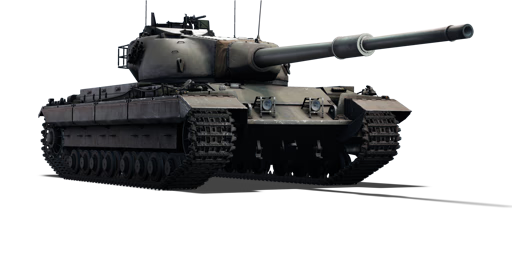



Following the reveal of the IS-3 during the 1945 Victory Parade through Berlin, the British realised the need for a new heavily armed and heavily armoured tank. Plans were drawn to create a "Universal Tank" hull, which would then be able to mount a variety of different armaments to suit a range of roles. The heaviest of this set of planned vehicles was the Conqueror, armed with a 120 mm gun inspired by and developed alongside that of the American M103, designed to be able to face down any Soviet threats and provide long-range anti-tank support for the existing Centurion.
By 1950, the new hull and chassis were nearing completion, while the gun and turret were still under development. Thus, a project to mount the turret of the Centurion Mk 3 was spawned, in order to ease the development process and train crews on the new hull, resulting in the Caernarvon. 1951 saw completion of the new gun and its acceptance into service, while the turret was still being finalised; plans for a stop-gap carriage for the new gun resulted in the Centurion hull-based Conway. Prototypes were complete by 1952, and the tank itself finally entered service in 1955, being sent immediately to armoured regiments stationed in West Germany. Both the Conqueror and Centurion were ultimately replaced by the Chieftain in 1966.
Introduced in Update 1.55 "Royal Armour" along with the initial British ground tree, the Conqueror deviates from most earlier British designs, favouring firepower and armour. With an extremely powerful main cannon, solid armour protection, and surprising (but still rather lacking) manoeuvrability for such a heavy vehicle, the Conqueror proves to be a highly effective sniper and support tank, able to crack open heavily armoured targets from long ranges. Making use of its strong armour and gun stabiliser allows it to also be put to good use in close-range brawls, although the subpar mobility and long reload can limit the vehicle in this aspect.
| Ammunition | Type | Armor penetration (mm) at a distance: | |||||
|---|---|---|---|---|---|---|---|
| 10 m | 100 m | 500 m | 1000 m | 1500 m | 2000 m | ||
| APDS | 502 | 496 | 474 | 447 | 422 | 398 | |
| HESH | 152 | 152 | 152 | 152 | 152 | 152 | |
| Belt | Belt filling | Armor penetration (mm) at a distance: | |||||
|---|---|---|---|---|---|---|---|
| 10 m | 100 m | 500 m | 1000 m | 1500 m | 2000 m | ||
| AP/T | 13 | 12 | 7 | 3 | 2 | 0 | |
| Belt | Belt filling | Armor penetration (mm) at a distance: | |||||
|---|---|---|---|---|---|---|---|
| 10 m | 100 m | 500 m | 1000 m | 1500 m | 2000 m | ||
| AP/T | 13 | 12 | 7 | 3 | 2 | 0 | |












Mobility | |
|---|---|
Protection |
|---|
Firepower | |
|---|---|